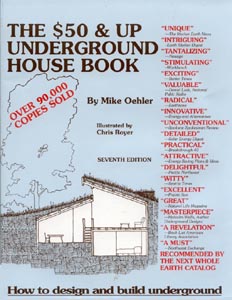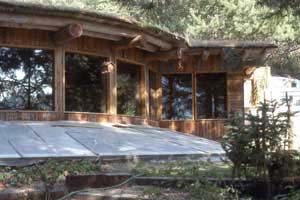|
No matter what kind of house you hope to build, if you are interested in low-cost innovation, then be sure to read Mike Oehler's The $50 & Up Underground House Book.
 Oehler is an out-of-the-box thinker who presents radically innovative house design and construction techniques. This book will stimulate your thinking and give you a fresh perspective on house-building design and construction. While unconventional and extremely low-cost, his techniques are entirely sound, and in many ways, engineered better than mainstream underground homes--although you might have trouble getting a building permit to apply his methods.
Oehler is an out-of-the-box thinker who presents radically innovative house design and construction techniques. This book will stimulate your thinking and give you a fresh perspective on house-building design and construction. While unconventional and extremely low-cost, his techniques are entirely sound, and in many ways, engineered better than mainstream underground homes--although you might have trouble getting a building permit to apply his methods.
The $50 & Up Underground House Book is not about building a dark, damp hole in the ground, but about building dry, well-ventilated, sunshine-filled homes that truly blend into the landscape. You will also learn how incorporate greenhouses, root cellars, and--if you desire--a fallout shelter. It is the only book on the market that explains the Post/Shoring/Polyethylene building method, which was developed by the author. The book covers hillside and flat land designs, and explains how to solve drainage problems with dependable gravity rather then expensive, failure-prone building materials.
But The $50 & Up Underground House Book does more than just cut your building material costs by up to 90%. It is widely recognized as the book which offers the reader the greatest possibilities for light, air and views in an underground home. Where most owner-designers and even professional architects are stuck on the disastrous "First Thought" concept, a design which greatly limits view, sunshine and air flow, and which usually causes staggering drainage problems, Oehler offers the "Basic Design" with the "Up Hill Patio" which solves these problems and more. He explains the weaknesses of the other three design concepts favored by conventional architects: skylights, vertical window wells and atriums. For example, though skylights admit a rewarding amount of light, they often leak, get dirty quicker, admit too much of the summer sun, too little of the winter rays, and offer no view whatsoever. They may have special applications, Oehler argues, but there are better design concepts for normal use.
 Now in its seventh edition, The $50 & Up Underground House Book has sold more than 90,000 copies and has received enthusiastic reviews from Mother Earth News, Whole Earth Catalog and many others. Many consider it the classic in its field. The $50 & Up Underground House Book discusses in detail more than 50 different topics related to underground construction. Included in the book are 4 pages of engineering tables and diagrams, 8 floor plans, 54 photos, and more than 100 illustrations. 115 pages. 1978. 7th Edition, 1997. Mole Publishing. ISBN: 0-442-27311-8.
Now in its seventh edition, The $50 & Up Underground House Book has sold more than 90,000 copies and has received enthusiastic reviews from Mother Earth News, Whole Earth Catalog and many others. Many consider it the classic in its field. The $50 & Up Underground House Book discusses in detail more than 50 different topics related to underground construction. Included in the book are 4 pages of engineering tables and diagrams, 8 floor plans, 54 photos, and more than 100 illustrations. 115 pages. 1978. 7th Edition, 1997. Mole Publishing. ISBN: 0-442-27311-8.
| Table of Contents
- Chapter 1: What an Underground House Is Not
- Chapter 2: What an Underground House Is - 23 Advantages
- Chapter 3: Histories of the $50 and $500 Underground Houses
- Chapter 4: The PSP System
- Chapter 5: Design
- The Basic Design
- Posts
- Elevation Changes
- Views, Light, Ventilation
- Five approved Methods of Design
- -Uphill Patio
- -Offset Room
- -The Royer Foyer
- -Clerestories
- -Gables
- Drainage
- Special Designs
- Flat-Land Designs
- Special Effects
- Special Features
- Patio Barbecue Area
- The Bachelor Bar
- Built-in Greenhouses
- Root Cellar/Fallout Shelter/Wine Cellar
- Built-in Coolers
- Chapter 6: Materials: Where to Buy and Scrounge
- Wrecking Buildings
- Windows
- Auctions
- Sawmill Lumber
- Polyethylene
- Concrete
- Fee Timber Sources
- Working Up Posts and Beams
- Chapter 7: Construction
- Secret Construction Method
- The Excavation
- Building the Structure
- Chapter 8: You And the Building Codes
- Appendices
|